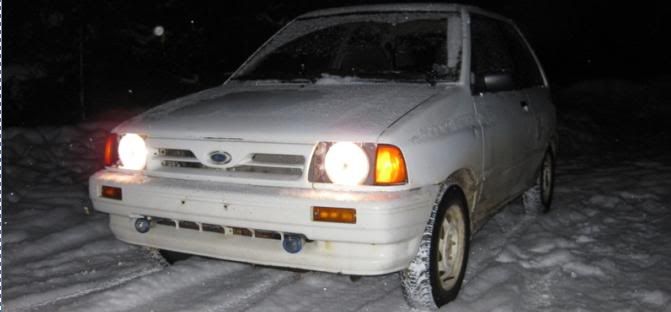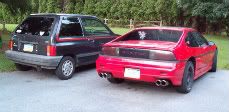the most ideal size (friction free scenario)is to keep it the same size the whole length of the exhaust, right form the down pipe, everytime you change the diameter of the pipe, you disrupt the flow and loose potential energy, (bernoulli's principal) you can usually go slightly larger then the down pipe size for your exhaust to make up for the extra restriction caused by the friction of the exhaust on the tubes walls as it travels the lenght of the exhaust, so roughly a 2 inch exhaust is a good size for our given down pipe, or make a new 2" down pipe and keep it a 2" exhaust, that way your opening up the exhaust and not changing the shape throughout the whole lenght
Announcement
Collapse
No announcement yet.
Exhaust tube size
Collapse
X
-
^funky, thats what I did, have you seen my latest "skeeter update thread"? i have a custom 2 1/8" DP + exhaust, only thing to disrupt flow is a cat (nececary for inspection).
Geneva... if you want to learn try reading the link i posted. Fancy that, it answers your question! whodathunkit?
As exhaust gasses are allowed to expand, they cool, and slow down, decreasing scavanging effect of the exhaust pulses... so a smaller diamiter pipe is more efficient for small displacement engines. larger displacement engines (or turbo/supercharged engines which are moving more air) benefit from larger pipes. There is a lot more to it than that too, i suggest you read a little if you want to learn. But back pressure is still bad, your not increasing back pressure with your smaller pipe, your actaully in effect decreasing it because of the increased exhaust gass velocity.
for further reading after you read the article I posted, google "exhaust theory", there is a lotta good info out there!~Nate
the keeper of a wonderful lil car, Skeeter.

Current cars:
91L "Skeeter" 170k, Aspire brakes, G15, BP, Advancedynamics coil overs, etc. My first love.
1990 Kawasaki Ninja 250 - my gas saver, 60+mpg - 40k
2004 MotoGuzzi Breva - my "longer range" bike - 17k
FOTY 2008 winner!
Comment
-
Well on my Swift GTi I had a complete 2" exhaust including a cat, no resonator and a 13" long stainless steel canister muffler, and it kinda felt slower...I think I've read that too big an exhaust can slow down flow, I.E. make the gases lose their inertia, and prevent proper cylinder scavenging which can cause reversion. And since you lose that vacuum effect given when the gases have enough inertia, induction suffers a bit, 'cause that vacuum isn't there anymore to help suck that intake air in during valve overlap. I'm not 100% sure about this, maybe Jim could straighten this out?The left lane? Are you crazy!!! I never drive in the left lane...It's full of freaks driving the wrong way and charging right at you!!!

Comment
-
Thanks for the link Nate.
Lots of variables here:
-engine type and size
-stock vs. custom engine work (including intake variables probably)
-exhaust manifold vs. header (and type of header)
-exhaust pipe diameter
-any differences in pipe diameter vs. component in/out diameters
-sizing and types of cat
-sizing and types of muffler
To really do a good test, you'd have to take your car to a dyno or a dragstrip and do several runs for a baseline score. Then change one variable at a time to see if you make more power or not. Again, three to five or more runs on each variation to eliminate chance.
To do a good job, you'd have to do many many tests with different combinations.
I guess if you had a programmer who knew enough, and a supercomputer, you might be able to crunch enough numbers to begin with and eliminate some of the variables. You'd still want to do some real world testing to confirm your hypotheses.
Now figure in costs and any weight differences between pipe sizes and components.
That's how I see it anyway.
Karl'93GL "Prettystiva" ticking B3 and 5 speed, backup DD; full swaps in spring!
'91L "AquaMutt" my '91L; B6 swap/5 speed & Aspire brakes, DD/work car
'92L "Twinstiva" 5sp, salvage titled, waiting for repairs...
'93GL "Luxstiva," '94 B6 engine & ATX; needs overhauled
'89L "Muttstiva," now a storage bin, future trailer project
Comment
-
also with too large a primary (or in our case, down pipe) the scavenging effect can be TOO great and actually suck out some fuel charge before it's used. effectively reducing the engine's displacement.Trees aren't kind to me...
currently: 2 88Ls (Scrappy and Jersey), 88LX, 90L(Pepe), 91L, 91GL (Skippy) 93 GL Sport (the Mighty Favakk), 94 (Bruce) & 95 Aspire SEs, 97 Aspire (The Joker),
94 Justy 4WD, 87 Fiero GT, plus 2 parts cars. That's my fleet.

Comment
-
Agreeing with multiple people with different arguments is messy, but its the case here. I would just set aside the funds to upgrade the system for the larger engine and leave it stock until i was ready for the swap. if you are just itching for change, just go 2". that is the size of plenty of 1.8 liter engines out there and they fun fine just like that. you will be happier in the long run not having to buy things twice.1993 GL 5 speed
It's a MazdaFordnKia thing, and you will understand!
Comment
-
I'm actually quite jelous of that down pipe as a matter of fact LOL I had a buddy try to build me a 2" one while I'm in the middle east and I just got an e-mail back from my girlfriend saying he did a brutal job and tried to make a 90 degree out of a streight pipe.................I can just imagine how it looks......even she said it looks pritty bad, so I guess I'll be takin that off when I get home LOL, I'll take some pics first if its really brutal and we'll have a good laughOriginally posted by skeeters_keeper View Post^funky, thats what I did, have you seen my latest "skeeter update thread"? i have a custom 2 1/8" DP + exhaust, only thing to disrupt flow is a cat (nececary for inspection).
Comment
-
LOL, i'd like to see that!!~Nate
the keeper of a wonderful lil car, Skeeter.

Current cars:
91L "Skeeter" 170k, Aspire brakes, G15, BP, Advancedynamics coil overs, etc. My first love.
1990 Kawasaki Ninja 250 - my gas saver, 60+mpg - 40k
2004 MotoGuzzi Breva - my "longer range" bike - 17k
FOTY 2008 winner!
Comment
-
The reason that you lost power with bigger exhaust is because the engine is making lots of hot gasses, to the back of the muffler. When over sizing the exhaust piping, the exhaust gasses have to push harder on the cold air in the piping. Cold air is heavier to push than hot. Go to this site and read it and, you will understand.Originally posted by GenevaDirt View Postif it does not need the backpressure then why does it matter what size pipes and muffler you put on it? I am not trying to argue, I am trying to learn. I put a bigger exhaust and cherry bombs on my car and the low end torque was gone along with what little passing ability these cars have, not to mention my gas milage dropped off. Once I put it back to stock exhaust the cars pep was back and so was my gas milage. If it is not back pressure that causes this then what is it?
:festiva: 1995 Kia Pride, 1.3 EFI, manual. :fred:
Comment
-
....little late on that reply.......Originally posted by NovaSS View Postisnt this thread almost a year old?

-"Hairlipstiva" 1991 GL 5spd (swapped from an auto), rolling on Enkei 14x6 +38 with 195/45/14 Toyo's, Jensen MP5720 CD deck, tach install, LED strip in cluster, down position rear wiper, FMS springs, Gabriel shocks on 4 corners, Acura Integra short shifter
-Escort GT 91 donor car with BP, G5M-R tranny to be dropped in the little guy...
-Aspire brake swap COMPLETE!
https://www.wunderground.com/persona...?ID=KOKOWASS38
Comment
-
Each to their own, on a stock B3, I'd go 1 5/8 and just try to make turns as smooth and non-restrictive as possible. Frankly big diameter exhaust is only useful if you are running high rpms and trying to get last ounce of power out of the thing such as racing. The head has to be ported and fuel system set up for high flow. For daily driver its just not needed. Same thing with people using huge carburetors, pointless unless the engine can use that much flow, most stock engines cant, especially at normal speeds. Best thing on a stock B3 would be to make sure it has clean cat and try to make turns around gas tank in back as smooth and free flowing as possible. I know my exhaust back there has kink from when I hit big rock and knocked muffler off. I unbent it but still a restriction there that needs to be gotten rid of. I notice power decreasing rapidly at higher rpm.
The whole setup has to be looked at as a system. A change in one component requires changes all around to compensate.Last edited by Banana Bonanza; 08-27-2009, 01:48 PM.
Comment
-
Congratulations lancerevo! You are todays winner!
 Search Master - Honorary Member of Midwest Festiva Inc., Gulf Coast Chapter
Search Master - Honorary Member of Midwest Festiva Inc., Gulf Coast Chapter
Everyone is entitled to be stupid, but some abuse the privilege.
- Unknown
I don't like superstitious people. They're bad luck. - Serge A. Storms
If at first you don't succeed, failure may be your style.
- Quentin Crisp
God, please save me from your followers!
- Bumper Sticker
Comment

Comment